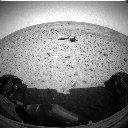Emily Lakdawalla • Jul 23, 2012
When will we see Curiosity's first images?
Numerous people have asked me when the first pictures will come back from Curiosity after landing. I sought out an official answer today. The short version is that it depends. It's most likely going to be about two and a half hours after landing. But it could be as early as minutes after landing, or as long as half a day after ("midday" California time).
Here's the longer version of the answer:
If we are very lucky, Curiosity will manage to transmit its first image during its first communication session with the Odyssey orbiter, minutes after landing. If so, the image will be a thumbnail (reduced-resolution) version of a photo taken from the front Hazcam. This is one of the cameras mounted to the rover's belly, and it's a black-and-white camera with a fisheye lens. As such it'll see a wide area, both the terrain right in front of the rover in reach of the arm, and the horizon in the distance (unless the rover is very tilted). However, as a thumbnail, it won't be very detailed: it will be only 128 pixels square. For comparison, here is Spirit's very first front Hazcam image taken after she put six wheels on soil, at 128 pixels. Curiosity's Hazcams have the same design as Spirit's.
During the next Odyssey overflight, near 1:00 in the morning California time (0800 UTC), Curiosity may transmit a compressed full-resolution rear Hazcam image. "Compressed" here means that its data volume is reduced using some lossy compression scheme, similar to JPEG compression. That'll be 1024 pixels square.
If that doesn't happen, the next chance for images will come from the transmissions Curiosity is scheduled to send during its morning on Sol 1, which is mid-day California time. The morning transmission will include images taken during Sol 0, the day of landing. This may include front and/or rear Hazcam images as well as a few thumbnails from MARDI, the camera that will take photos of the ground under Curiosity as it descends.
UPDATE: Thanks to a friendly reader who knows how to read JPL's SPICE data (which describe the trajectories of spacecraft), I have more specific information on the timing of Curiosity's first few communications opportunities with Odyssey and Mars Reconnaissance Orbiter. These were computed a couple of days ago and may be slightly inaccurate by now (especially given the fact that Odyssey adjusted its orbit yesterday), but actual times will be in the same ballpark. At the time of landing, one-way light time between Mars and Earth is 13 minutes 48 seconds, so add that to get Earth Received Time (ERT).
| Orbiter | Pass start (time at Mars, not ERT) | Sol | Local Solar Time | Duration (min) | Max elevation (deg) | |
|---|---|---|---|---|---|---|
| UTC | PDT | |||||
| MRO | AUG 06 05:11 | AUG 05 22:11 | 0 | 14:57 | 12.3 | 72.9 |
| Odyssey | AUG 06 05:13 | AUG 05 22:13 | 0 | 14:59 | 14.4 | 20.5 |
| Odyssey | AUG 06 07:10 | AUG 06 00:10 | 0 | 16:53 | 13.4 | 14.3 |
| MRO | AUG 06 17:24 | AUG 06 10:24 | 1 | 02:50 | 12.3 | 85.2 |
| Odyssey | AUG 06 17:59 | AUG 06 10:59 | 1 | 03:24 | 16.4 | 40.2 |
| MRO | AUG 07 05:30 | AUG 06 22:30 | 1 | 14:37 | 12.3 | 42.9 |
| Odyssey | AUG 07 06:52 | AUG 06 23:52 | 1 | 15:57 | 15.4 | 69.6 |
All of this may sound very wishy-washy. The fact is that we won't know until the rover is sitting on the surface of Mars exactly how everything will perform. Curiosity may surprise us, as Spirit and Opportunity did, with a wealth of photos returned during the first pass. Then again, it may not. Lack of images at any of these times doesn't necessarily mean a problem with the mission. On the other hand, I'll be the first to admit that I'm hoping that these statements are all conservative, and we'll see more pictures.
But do remember that the days after landing will be taken very, very, very cautiously by the rover team. When I hunted down that Spirit Hazcam image from the MER Analyst's Notebook, I was reminded that Spirit didn't roll off her lander until Sol 12. That's nearly two weeks of instrument checkouts and the careful step-by-step process of commissioning Spirit for her first timid steps onto Martian soil. Curiosity will have a head start over Spirit and Opportunity, because there's no egress phase; the new rover will start its mission with six wheels already on soil. But don't expect them to drive any distance with any speed! Be patient, and we'll have years to watch this adventure unfold.
Support our core enterprises
Your support powers our mission to explore worlds, find life, and defend Earth. You make all the difference when you make a gift. Give today!
Donate

 Explore Worlds
Explore Worlds Find Life
Find Life Defend Earth
Defend Earth


